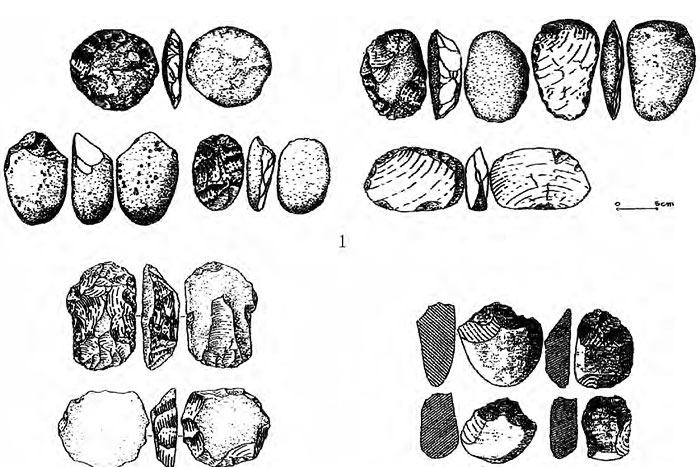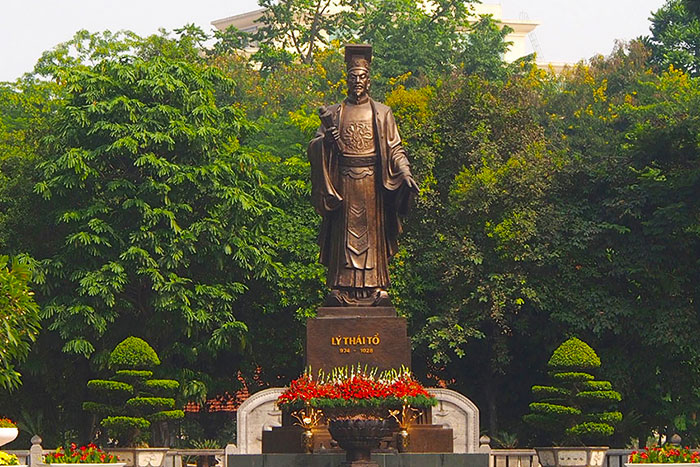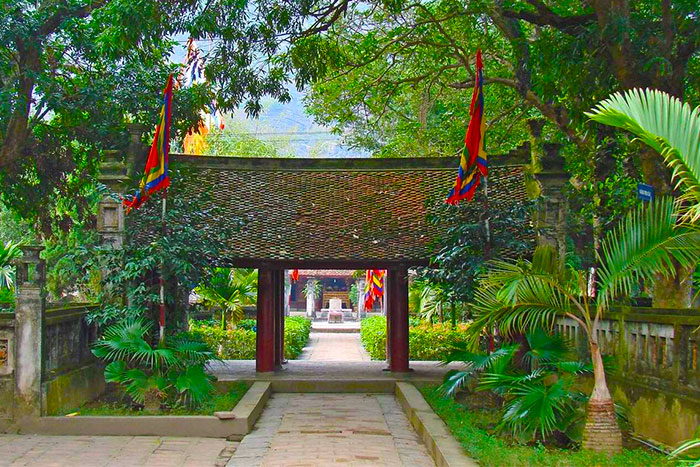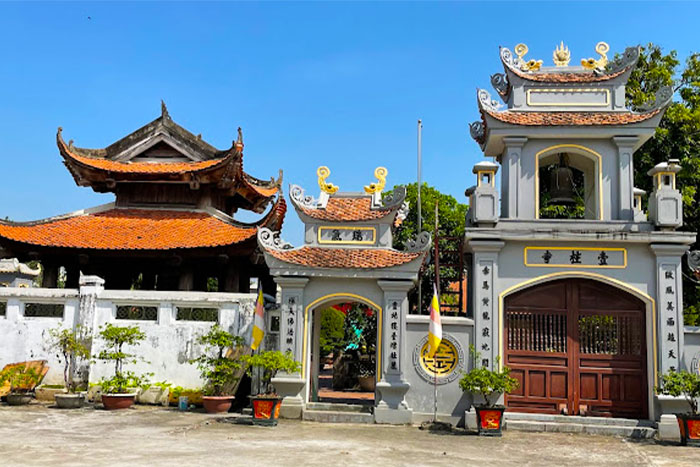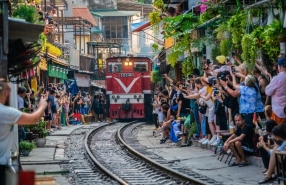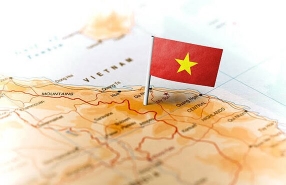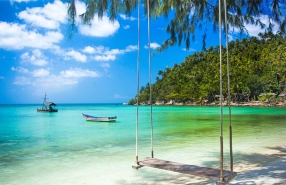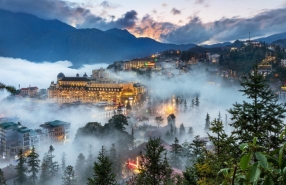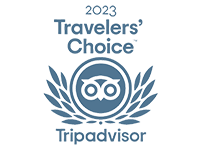Hoa Lu Ancient Capital, nestled within the Trang An Scenic Landscape Complex, beckons visitors with its rich cultural and historical allure. Time may have gently aged its surroundings, but the ancient capital retains undisturbed tranquility, exuding a majestic charm that serves as a golden testament to a bygone era of national heroism. Admire the enchanting Hoa Lu Ancient Capital and discover the time-honored historical treasures that await you. There are many things to see in Hoa Lu Ancient Capital amidst its quiet grandeur, where every corner echoes with the storied past.
1. About Hoa Lu Capital - Ancient Heroic Nation
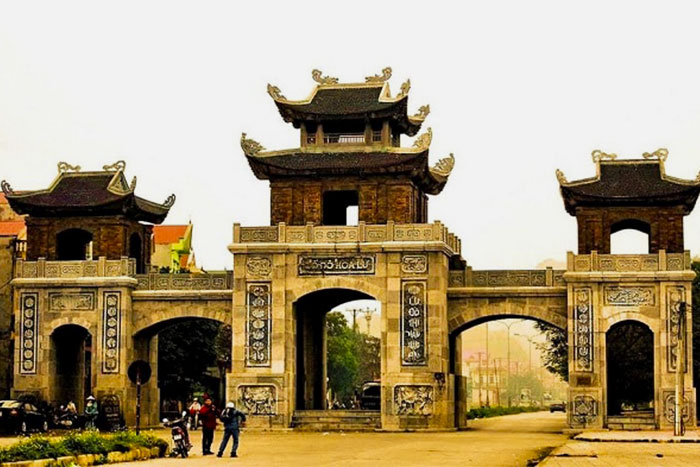
"Hoa Lư động" (花廬峒) translates to "Cave of Reed Flowers," where "Hoa Lư" means "Reed Flowers." However, the capital city of Hoa Lư (花閭京都) holds a different significance, signifying the "Flower Village." A dream, a picturesque vision intricately painted by King Đinh, emerges from a single change in the character "Lư." The transformation from "Lư" (廬), meaning "reed", to "Lư" (閭), meaning "village," brings about a profound distinction.
The idea of constructing a nation as splendid as a flower village was born from this subtle alteration. It is an aspiration, a panoramic scene envisioned by King Dinh. The concept transcends from the humble thatched reeds to the grandeur of a flourishing village.
When visiting Hoa Lu Ancient Capital Vietnam, you’ll have the opportunity to partake in numerous traditional cultural festivals. Among these, the most significant and grandiose is the Truong Yen Festival, celebrated every 10th day of the third lunar month (around April and May). This vibrant festival commemorates the esteemed Kings of the Dinh and Le dynasties, namely Dinh Tien Hoang and Le Dai Hanh. The festivities unfold in two parts: a solemn ceremony at the Truong Yen water station along the Hoang Long river and reverence at the two majestic temples dedicated to the revered Kings. Spanning three delightful days, the Truong Yen Festival boasts a plethora of entertainment. From the captivating "Co lau tap tran" (Cỏ lau tập trận) performance to engaging activities like Han script writing competitions, chess matches, and the enchanting dragon dance, visitors are immersed in a celebration that perfectly captures the local legends. These traditional games not only amuse but also give you an unforgettable and enjoyable experience about the rich culture of the area
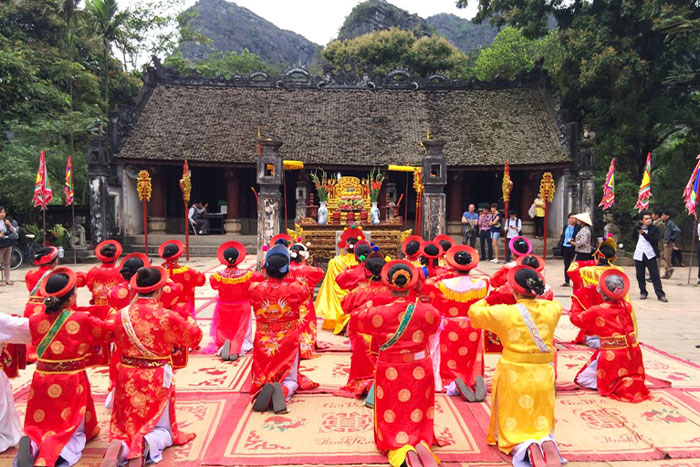
2. History of Hoa Lu Ancient Capital - Uncover the fascinating past
2.1 The Time Before Hoa Lu Was Established
The Hoa Lu Ancient Capital relic now graces the border between the Hoa Lu and Gia Vien districts in Ninh Binh Vietnam, creating an enchanting tapestry of history. Nestled at the foot of a mountain in this alluvial land, human settlement traces date back to ancient times.
Archaeologists, delving into this rich landscape, unearthed the fossilized remains of orangutans and terrestrial animals from the Paleolithic era, showcasing the deep roots of the Trang An culture. Caves, bearing signs of human habitation during the Hoabinhian period, add a fascinating layer to this historical canvas.
As time progressed, the land witnessed a thriving community of Neolithic-age inhabitants. The Trang An World Heritage Site complex in Hoa Lu preserves relics from 30,000 years ago, offering glimpses into prehistoric life, ancient dynasties, and erstwhile capitals.
Through the ages, this area held significance in various realms, from the Cuu Luu tribe during An Duong Vuong's time to its tenure in the Cau Lau and Giao Chi districts during the Han Dynasty and Three Kingdoms period. In the Tang Dynasty, it found its place within Truong Chau.
Notably, the landscape played a pivotal role during the Ngo Dynasty, serving as the stronghold of Dinh Bo Linh. His successful defense against the central government's attack from Co Loa in 951, led by Thien Sach King Ngo Xuong Ngan and King Nam Tan Ngo Xuong Van, further solidifies this area's storied and resilient history.
2.2. The Establishment of Hoa Lu - The Nature’s jewel
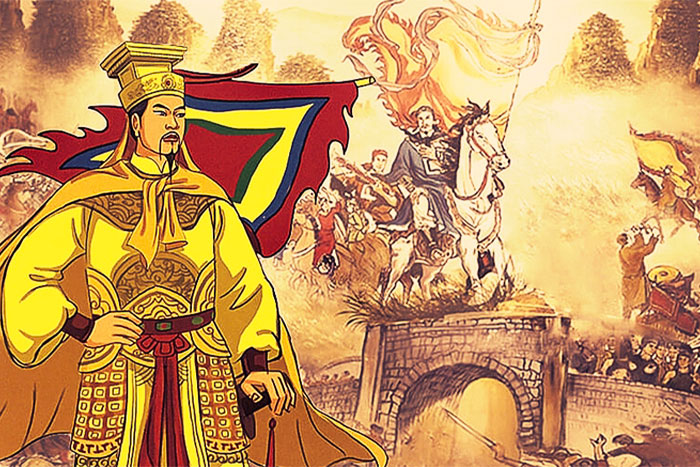
In the year 968, Dinh Bo Linh successfully quelled the rebellion of 12 warlords, achieving the unification of the country. As he ascended the throne, he marked the beginning of the illustrious Dinh Dynasty, making him the first emperor of Vietnam after 1000 years of Northern domination. King Dinh Tien Hoang named the nation Dai Co Viet, and he chose Hoa Lu as the capital of the country. This event this an important milestone of the history of Hoa Lu Ancient Capital.
The natural geography of the capital city Hoa Lu is beautifully depicted:
"Hoa Lu is a place where majestic mountains and hills converge. Mountains surround rivers, and rivers flow through mountains. It is strategically located with convenient access to both land and water. Behind us are lush forests, ahead stretches a vast plain, and in the distance lies the expansive sea. In this picturesque landscape, mountains and rivers harmonize, creating a place worthy of being chosen to build a capital."
Dinh Tien Hoang successfully ended territorial division, restoring unity to the country. However, after ruling for 12 years, Dinh Tien Hoang was assassinated. His third son, six-year-old Dinh Toan, then ascended the throne. Seizing the pretext of a Song invaders' invasion, Empress Dowager Duong Van Nga and her courtiers placed General Le Hoan on the throne, establishing the Le Dynasty.
2.3. The Early Le Dynasty (Nhà Tiền Lê)
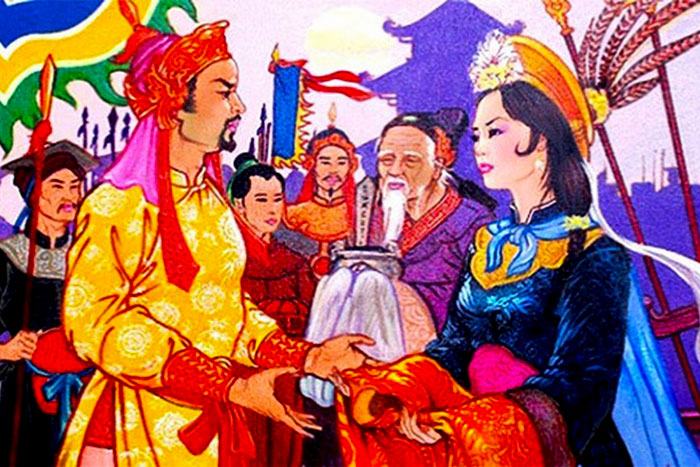
When the Hoa Lu court faced adversity, the Song Dynasty in China sent troops to invade Dai Co Viet. It was in this challenging context that figures like Empress Dowager Duong Van Nga, General Pham Cu Lang, and other sagacious mandarins proposed Le Hoan to assume the throne. King Le Hoan led the army in repelling invasive forces, from the Chiem people to the Song Dynasty in China.
His remarkable leadership not only defended the borders with unwavering determination but also laid the groundwork for expanding the nation's territory. That's why Hoa Lu remained the imperial capital during the Early Le Dynasty
As the dynasty continued, Le Long Dinh, the son of Le Dai Hanh, ascended the throne, achieving numerous glorious feats. However, his death at the age of 24 marked the end of the Former Le Dynasty, ushering in a new era under the Ly Dynasty. The history of Hoa Lu Ancient Capital underwent a significant change after this event.
2.4. The Ly Dynasty – Relocation of The Capital to Thang Long
In 1010, King Ly Cong Uan relocated the capital from Hoa Lu Ancient Citadel to Dai La Citadel, renaming it Thang Long, which is now known as Hanoi. Historians suggest that Ly Thai To recognized the limitations of Hoa Lu's narrow space for the country's expanding stature, leading to the issuance of the "Chieu Doi Do."
This momentous shift marked a significant event in the history of Hoa Lu and Thang Long. The capital of Hoa Lu lasted for 42 years, with the Dinh dynasty ruling for the first 12 years (968–980), followed by the Tien Le dynasty for the next 29 years (980–1009), and the final year (1009–1010) under the Ly dynasty.
Today, Hoa Lu Ancient Capital continues to hold a pivotal role in Vietnam's architectural and historical landscape. Recognized as one of the four cores forming the UNESCO World Heritage Site – Trang An Complex, it stands as a testament to the rich and enduring heritage of Vietnam.
3. Visit top must-see attractions in Hoa Lu Ancient Capital
There are numerous things to see in Hoa Lu Ancient Capital:
- Temple of King Dinh Tien Hoang
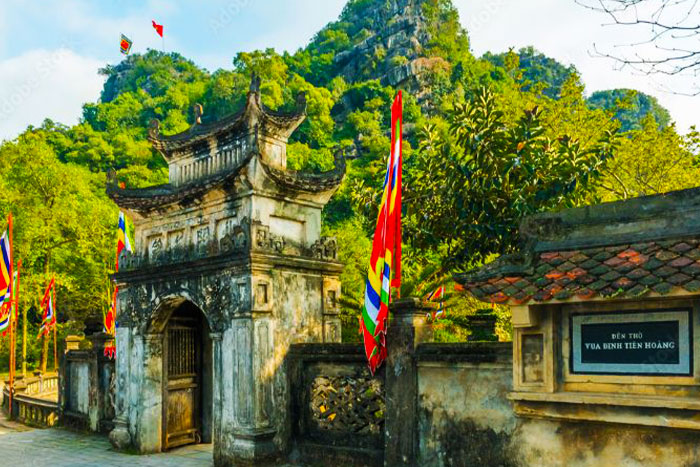
The Temple of King Dinh Tien Hoang stands as a distinctive architectural gem within Hoa Lu Ancient Capital, nestled at the foot of Ma Yen Mountain. Crafted by Vietnamese artisans in the 17th century, this masterful blend of wood and stone carving exudes an ethereal and timeless beauty, offering a glimpse into the city's ancient past.
- Temple of King Le Dai Hanh
The Temple of King Le Dai Hanh, also dating back to the 17th century, comprises three sections: the front shrine, Thien Huong House, and the Sanctum dedicated to King Le. Although smaller than King Dinh Temple, it shares a similar architectural style, creating a harmonious ensemble. The temple features a prominent altar and a grand drum at the front, while the back showcases exquisite depictions of King Le Dai Hanh, his wife, and his son, King Le Long Dinh.
- Nhat Tru Pagoda (One Pillar Pagoda)
Built in the 10th century, this pagoda is a sacred space intertwined with the history of the former imperial capital. Encompassing over 3,000 square meters, the pagoda follows the Dinh architectural style in its five front halls, three upper halls, and a south-facing tiled roof. The wooden front hall is adorned with stylized lotus blossoms and twisted foliage from the Nguyen dynasty, while the truss structure design of the upper hall features pillars intricately carved with dragons and swords, reminiscent of the Le Dynasty.
Rising to an elevation of approximately 200 meters, Ma Yen Mountain earns its name due to its resemblance to saddles. This mountain is steeped in legend, notably linked to the tale of Dinh Bo Linh, who selected this mountainous terrain to establish the capital.
When Dinh Bo Linh passed away, his body was laid to rest atop the mountain. Additionally, at the southern foothills of Ma Yen, one can find the tomb of King Le Dai Hanh.
For those who ascend to the summit of Ma Yen, a breathtaking panorama of the ancient capital of Hoa Lu unfolds. Admiring everything from the top is one of many interesting things to do in Hoa Lu Ancient Capital.
Am Tien Cave, also known as Tuyet Tinh Coc in Hoa Lu, is not only a breathtaking natural landscape but also a cultural treasure with enduring significance. This site seamlessly combines lakes, mountains, and temples, presenting an irresistible allure. Witness the captivating harmony of limestone peaks, a serene lake, and a diverse ecosystem, with Ao Giai Lake standing out as a focal point—its crystal-clear waters mirror the majestic mountains that surround it. This site is a haven for those seeking a tranquil escape into nature, making it a destination worth visiting among many things to see in Hoa Lu Ancient Capital.
Within this complex are three shrines: the inner shrine dedicated to honoring King Dinh Tien Hoang, the middle shrine named Thien Huong, and the outer shrine known as Ngo Mon Gate. Each shrine adds to the cultural richness of Am Tien Cave, inviting visitors to delve into the historical and spiritual layers that grace this enchanting destination in Hoa Lu.
4. Best time to visit Hoa Lu Ancient Capital
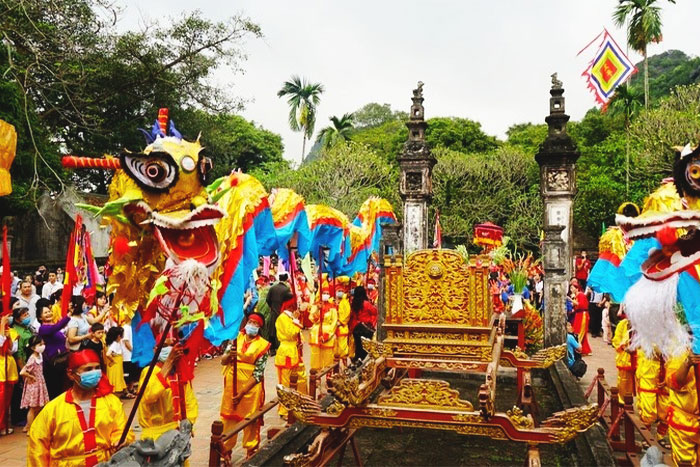
Visiting Hoa Lu doesn't impose a strict time constraint. However, according to the recommendations of the Vietnamese people, spring is often considered the most beautiful season to explore Hoa Lu in Ninh Binh. During this time, numerous stunning festivals unfold after the Lunar Tet holiday. It's an ideal period for those who relish vibrant atmospheres and bustling crowds at the festivals.
For those who prefer a quieter experience and wish to savor the peaceful ambiance of the area, other seasons are equally delightful. Regardless of when you visit, you can still appreciate the full beauty of Hoa Lu, with its historical sites, unique landscapes, and restaurants offering the idyllic cuisine of the Northern region—all contributing to the charm that attracts tourists to Hoa Lu.
5. Transportation to Hoa Lu Ancient Capital
How to get to Hoa Lu Ancient Capital? To get to this place, you first need to travel to Ninh Binh from Hanoi. Here are various transportation options:
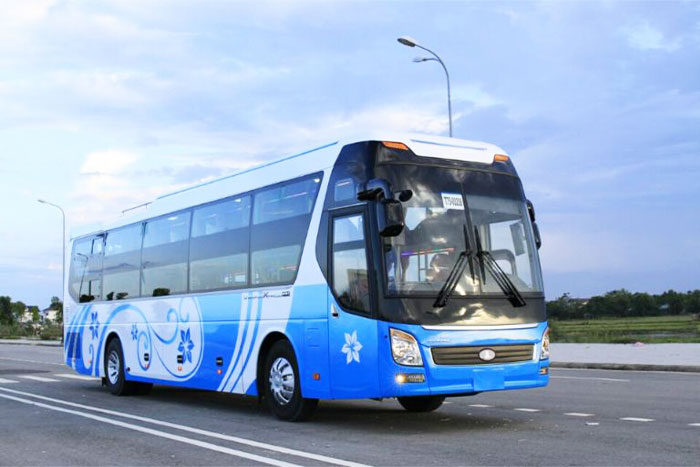
You can easily find the Ha Noi - Ninh Binh bus route from multiple operators at the Giap Bat or My Dinh Bus Station in Hanoi. Ticket prices are affordable, ranging from 120,000 VND to 150,000 VND per person. Buses run every 30 minutes from 5:00 AM to 11:00 PM daily.

Starting from Giai Phong Street, head towards Phap Van - Cau Gie Highway and proceed straight. Follow the signposts along the roads until you reach Ninh Binh Province. Once in Ninh Binh, it's a quick journey to Hoa Lu Ancient Capital of Vietnam.
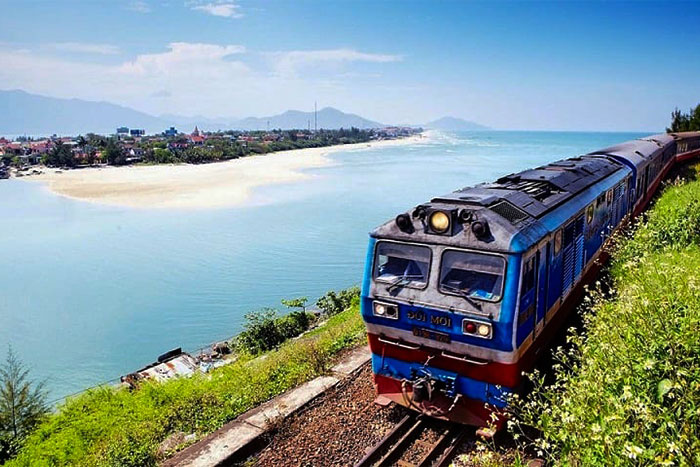
Train ticket prices from Ha Noi to Ninh Binh vary from 120,000 VND to 200,000 VND, depending on the train type and seat. Ensure you purchase your train tickets before the departure time. The train stops at Ninh Binh Train Station, where you can either pick up a taxi or rent a motorbike to reach Hoa Lu.
6. Helpful tips
- Hoa Lu Ninh Binh is a spiritual tourist destination, and visitors are encouraged to wear long clothes when entering the temple.
- Maintain a quiet and respectful atmosphere, and remember to take off hats or sunglasses while inside King Dinh-Le Temple.
- If you're traveling independently, it's advisable to bring a map of the Hoa Lu tourist complex to enhance the experience.
Leaving indelible marks in its role as the first capital of our country, Hoa Lu Ancient Capital still preserves the pristine essence of bygone eras. The robust walls, adorned with moss, vividly narrate the historical ebbs and flows, inviting us to appreciate the profound mountains, rivers, and landscapes. For a deep understanding of Vietnam's dynastic architecture and rich history, exploring and admiring many things to see in Hoa Lu Ancient Capital is truly worth the visit to Ninh Binh. To ensure a satisfying experience far beyond your expectations, please CONTACT AUTOUR ASIA, TRAVEL AGENCY VIETNAM now.



